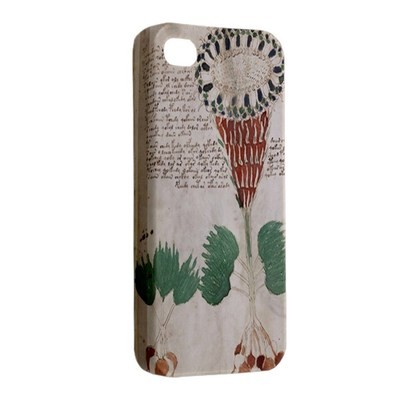A fulsome tip of the Cipher Mysteries hat to Luck Thief Luke Fitch for passing on a link to this (actually rather nice-looking, I think) Voynich-themed iPhone4 case shipped all the way from Hong Kong. Luke bought one for his girlfriend for Christmas “and she loves it“, thus proving once and for all that romance and cipher mysteries can indeed co-exist. (Though I’m not entirely sure my wife would 100% agree.)
As I’m sure at least 20% of Cipher Mysteries regulars will know, the image chosen is cropped from page f40v, the end page of the Voynich Manuscript’s Quire 7. The plant depicted is very similar-looking to the (marginally better-known) plant on f33v, which Hugh O’Neill in 1944 thought was a “sunflower”: Robert Brumbaugh also thought this was the case (though much later).
However, because of a number of compelling counter-arguments raised by Jorge Stolfi, the whole sunflower notion now seems to have, errm, had its day in the sun. More recent alternatives include:-
* Dana Scott suggested in 2001 that it might be related to Epiphyllum oxypetalum;
* Edith Sherwood suggests Crocus vernus;
* Berj N. Ensanian suggests that comparisons with giant Pitcher plants present themselves.
What I can say is that it’s a Herbal ‘B’ page written (as usual) in Currier Hand 2, with a ‘title’ (offset text block) on the bottom-most line. There is only a single l-initial word (‘lar’), and a fair smattering of single-leg gallows. I don’t think its roots or leaves are repeated in either of the later pharma sections.
Even though this is quite vividly coloured, I don’t personally believe this is actually a plant… but that’s another story entirely! 🙂

pro bono publico, of course
http://www.beyondweird.com/occult/alt.html
oh – plant.
I’d say one of the Proteaceae – P. lepidocarpodendron;
P. subvestita; P. repens. If similarity is intentional here to the lotus – as seems to be – the earlier maker was as obsevant as the later scribe/s. Western science only recently recognised the lotus-like Nelumbonaceae as being related to the Proteas: not immediately related – but both within Proteales. Why the roots are like white and brown turnips, (or alternatively like Macadamia nuts) I’m not sure. Perhaps Theoprastus will tell.
– I expect its a perceived likeness to the western artichoke.
I wonder if there are some copyright issues with that. Can the images be used in commercial product without permission?